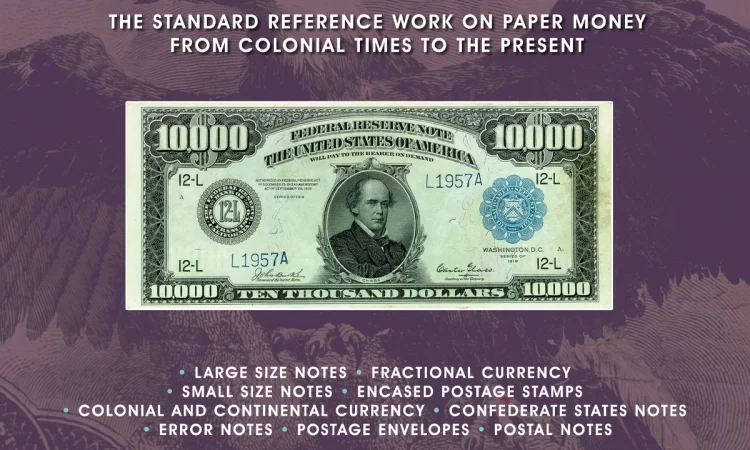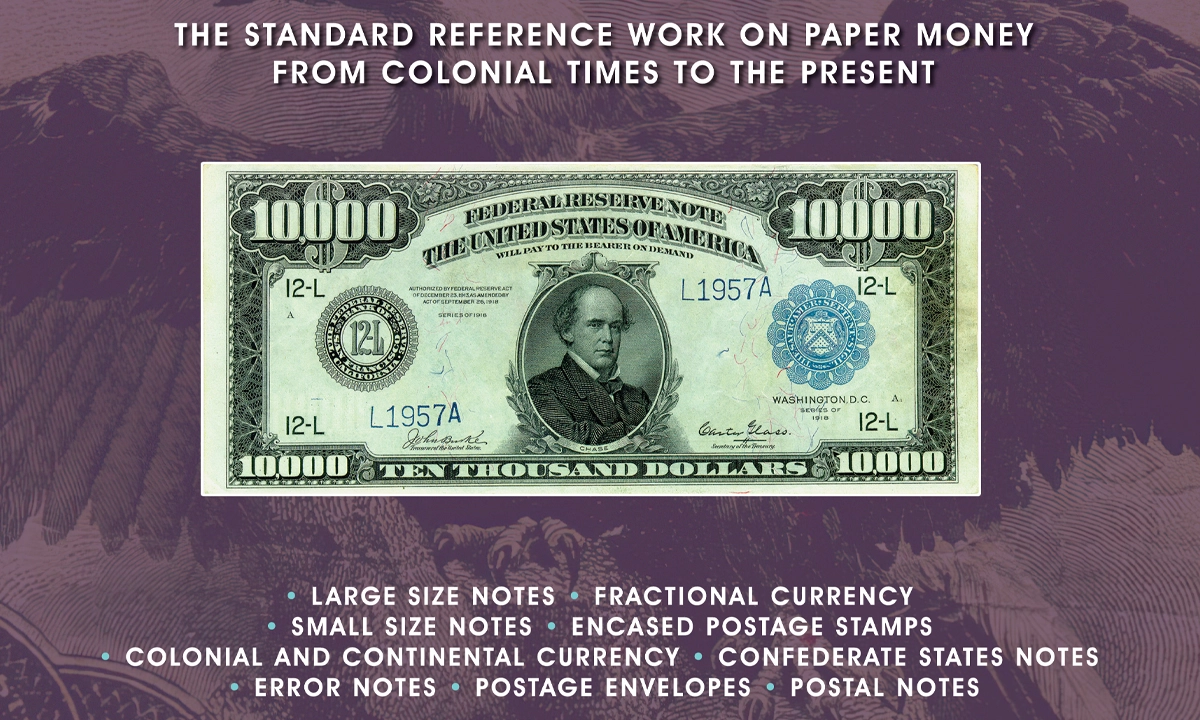

Seventy-one years after its first edition, the 23rd edition of Paper Money of the United States, the standard reference book on American currency, is being released by the Coin & Currency Institute in July 2024. In 1953, the late Robert Friedberg (1912-1963) broke new ground when the Treasury Department granted permission for photographs of American paper money to be printed for the first time. The current edition’s 336 pages feature notes from America’s greatest currency collections, as well as most of the greatest rarities, all reproduced in color.
The inaugural edition of Paper Money of the United States also introduced other innovations never before attempted. The subject became standardized, and the book earned a permanent place on reference shelves. Over the past four decades, it has been expanded, revised, and edited by Arthur L. Friedberg and Ira S. Friedberg.
The 23rd edition of Paper Money of the United States, as any price catalog, is a snapshot in time – and as the new edition debuts, it shows that the market for paper money is stable or rising in all categories. Notes of great rarity or top quality often establish price records every time they are sold. All valuations in the new edition have been adjusted, mostly upward, to reflect market conditions. These prices are given in up to seven states of preservation, from Very Good (VG8) to Gem Uncirculated (Gem65). A major addition is the expansion of the section on the Treasury Notes of the War of 1812 to include those issued from 1837 to 1860. There are also several other additions and revisions to the new volume, including notes never known to exist, making it a necessity for every collector and dealer of American currency.
From the first year of federal paper money (1861) to the present, the fronts and backs of all classes and types of currency, from three cents to $10,000, are illustrated. These are accompanied by text listing, describing, and pricing every variety of paper money ever issued – more than 10,000 prices in all. With close to 1,000 color photographs, the result is a complete pictorial, descriptive and numismatic history of the currency of the United States. There are supplemental sections on Continental and Colonial Currency (notes issued from 1680 to 1788); Treasury Notes from 1812 to 1861, considered by some to be the first national currency; a comprehensive listing by type of the issues of the Confederate States of America; and sections devoted to paper money errors, postage envelopes, a section on postal notes, and encased postage stamps. The latter three, along with Fractional Currency, were created to alleviate the shortage of change needed for commerce during and after the Civil War.
The listing in the Appendix of the 14,348 National Banks that existed from 1863 to 1929 also shows the number of large size and small size notes known to exist for each note-issuing bank. The Appendix also includes information on uncut sheets of small-size notes, including the modern issues sold by the Bureau of Engraving and Printing. Paper money collectors depend on the Friedberg Numbering System, a uniform method of cataloging bank notes that is the international standard for American currency. This numbering shorthand, along with the hundreds of photographs, enables anyone to instantly locate a specific banknote, and allows a dealer to advertise a note without need of extensive description. A distinguished panel of acknowledged experts on paper money has assisted the authors, enabling them to establish accurate and up-to-the minute valuations for all issues.
Paper Money of the United States has been an invaluable asset to currency collectors and numismatists for generations. It possesses an appeal and value of its own, not just to lovers of Americana and of the fine art of engraving but also to students of American history, finance, and economics. It is recognized as a landmark work and is the undisputed standard reference on American currency – internationally acknowledged as the most comprehensive and universally quoted guide on the subject. Banks in America and throughout the world will find this book especially useful in that it makes possible the immediate identification of all obsolete but still legal tender paper money, while simultaneously giving the collector’s value of each note. It is a book that belongs in every library, public and private.
Sample pages from the 23rd edition may be seen on the book’s website below. The 8½” x 11″ book is available in two printed and two electronic versions: A hardcover with sewn binding (ISBN 978-087184-723-2) is $69.95 and a softcover volume (ISBN 978-087184-523-8) is $48.95. Free shipping is included in the United States. There are also two e-book options for $29.95 each. A USB stick (PC only) and a downloadable version at https://www.ebookshop.coin-currency.com/us/ that can also be purchased as a daily rental for $4.99.
The Friedberg Paper Money of the United States is available from bookstores, coin and paper money dealers, and internet book sellers once trade orders are fulfilled. It may also be ordered from the publisher, Coin & Currency Institute, at P.O. Box 399, Williston, VT 05495, toll free at 1-800-421-1866 or online at www.PaperMoneyoftheUS.com.
* * *






